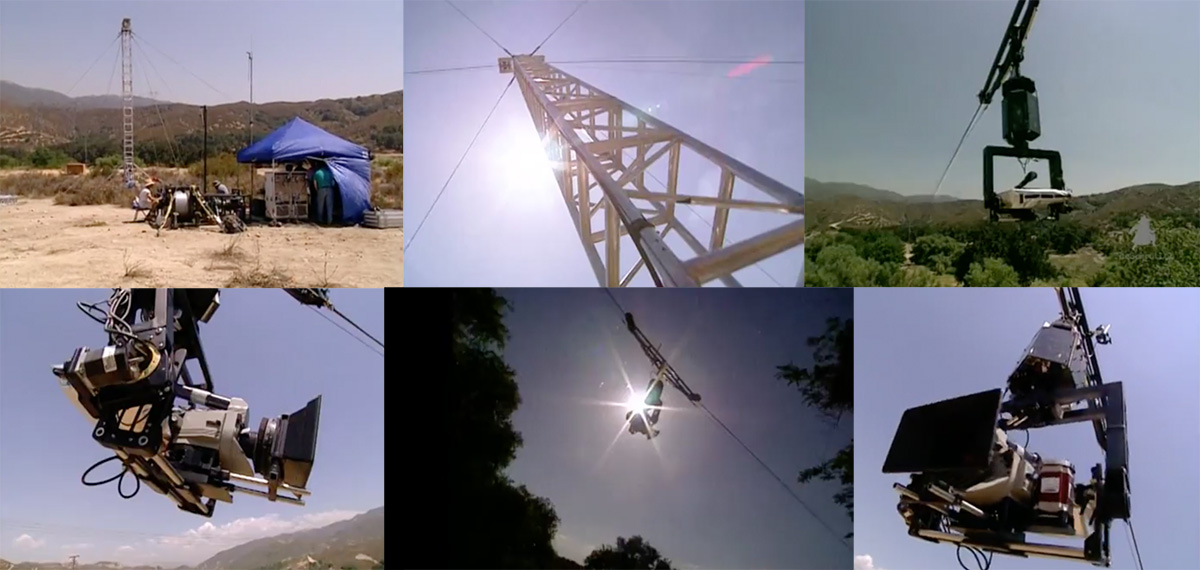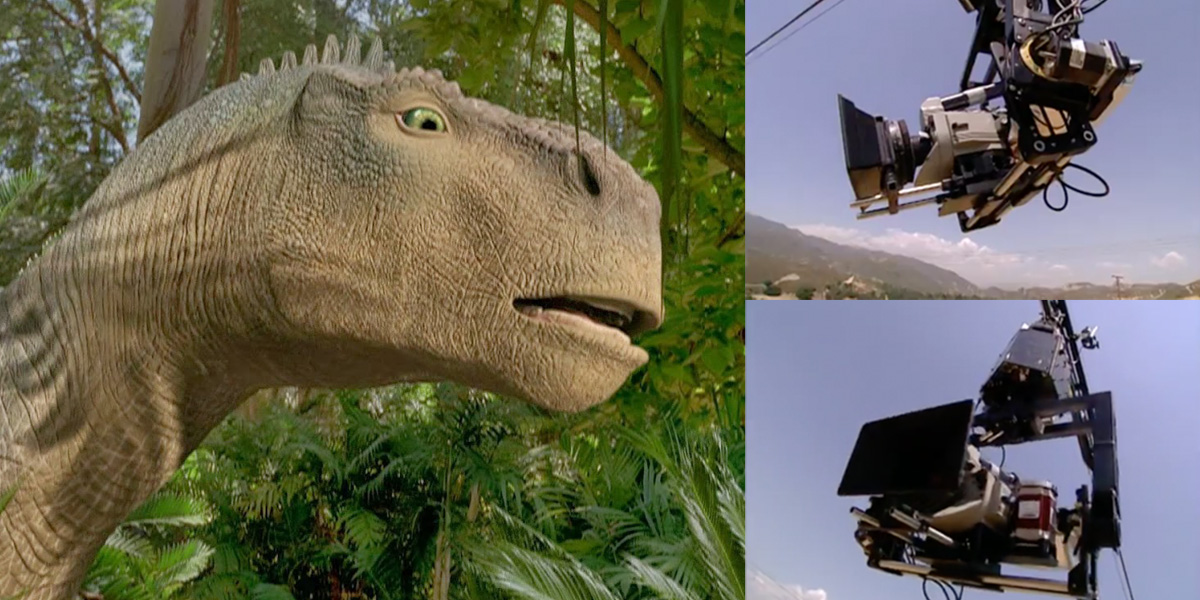Getting that dino point of view.
Twenty years ago, Disney released Dinosaur, directed by Eric Leighton and Ralph Zondag. The live-action/CG hybrid was a production by Disney’s Feature Animation Northside that ultimately segued into The Secret Lab (formerly Dream Quest Images). In the movie, digital dinosaurs – and lemurs – were composited predominantly into live-action backgrounds filmed at numerous locations around the world.
One of the methods for filming live-action from the higher points of view of the dinosaurs came in the form of a motion controlled cable camera rig dubbed ‘Dino-cam’. It would involve suspending a camera carriage on a cable between two large towers and shuttling the carriage at 30 miles per hour to capture the feeling of a running dinosaur.
To celebrate the film’s two decade anniversary, I thought I’d ask one of Dino-cam’s engineers, Steve Kosakura, about how the rig came about. Kosakura had already worked at several VFX facilities on camera rigs, and after Dinosaur went on to work for Walt Disney Imagineering. Here’s his look back at the Dino-cam tech.

b&a: Before Disney, you’d done a great amount of work in camera tech at various visual effects studios. How did that end up leading to Dinosaur?
Steve Kosakura: Well, when I was at Boss Film working for Richard Edlund, we did the movie Cliffhanger with Sylvester Stallone. At that time my visual effects director of photography was Neil Krepela. We hit it off while we were in Italy working on Cliffhanger and kept in touch since then and actually have continued on as lifelong friends. He was going to be at the lead of putting the visual effects together for Dinosaur.
We were talking through the possibilities of how we could pull off some of these shots because they wanted to do real backgrounds and marry that with the CG dinosaurs. Some of the shots they needed were from the dinosaur point of view or the dinosaur perspective. And then another friend, Dwayne McClintock, also came on board for the project.
b&a: What led to you and the team building the Dino-cam system?
Steve Kosakura: We looked at some other systems and thought we would probably be better served by building our own system, which is no small feat when you’re doing something that large. The idea was that this was going to be capable of standing up to a 1000 feet and able to move at up to a 30 miles an hour, which is a pretty good clip. There’s some pretty serious forces on your mechanics and your rigging and everything else when you’re talking about suspending steel cables over that kind of distance and trying to get the kinds of speeds that we were getting.

b&a: What were the components that went into making Dino-cam?
Steve Kosakura: There were a lot of parts to it. There were some very large drum winch drives that were used. There was the main suspension cable that the entire system flew on; it was the main cable that ended up being effectively the track. The camera carriage was a large sled that was suspended on the main suspension cable and was pulled back and forth by a loop that went to the far tower.
Then there was a whole wireless radio-linked motion control system along with video coming back to us for both controlling and seeing what the shots were on preview.
The original version was a Nettman head that we were using. The Nettman was an underslung yoke configuration. We also used several L-shaped camera heads that we had designed and built ourselves.
b&a: You used the Dino-cam to get these high above the ground POVs. When you were shooting scenes was there anything there in the frame, like a jeep standing in for a dinosaur or something similar, or was it just purely filmed as clean plates?
Steve Kosakura: For the finished product they were clean plates. When we were setting up and doing initial tests, one of the places we were set up was a large parking lot that was across from where our unit was located. The rig was set up down there for a whole series of tests and repeats. We had some golf carts at one point in time down there and we did some experimentation with trying to do follow shots but they were a little bit clumsy.

b&a: What challenges did you face with stabilization?
Steve Kosakura: Well, starting and stopping was a completely different issue than just trying to run at a fixed speed. Once we got our accelerations up to speed and we were able to get to a running speed, as it were, it was not too bad on stabilization. We did experiment with some mechanical gyros at one point in time, but I don’t think we ever used them for any of the actual production shots.
b&a: What was the motion control side of the rig used for, in particular?
Steve Kosakura: The motion that was shot by the camera system itself was typically pre-designed. Dwayne McClintock was the operator during that and he ended up programming moves. We would shoot the moves with the Dino-cam system and in some cases we actually repeated the moves for the purposes of adding and subtracting elements. It was pretty surprising that, at least on the wider lenses, the repeats were very, very good.
We attempted some experiments with some longer lenses. Between the combinations of both pendulous motion as well as some of the bounce and some of the other things, we had some issues with repeating some of that motion. So in some cases there was some post tracking that was done to take some things out. But a lot of it was a was right out of the camera.























